STANDARD METAL DESIGNATIONS
7-4. GENERAL
The numerical index system for the classification of metals and their alloys has been generally adopted by industry for use on drawings and specifications. In this system, the class to which the metal belongs, the predominant alloying agent, and the average carbon content percentage are given.
7-5. STANDARD DESIGNATION SYSTEM FOR STEEL
a. Numbers are used to designate different chemical compositions. A four-digit number series designates carbon and alloying steels according to the types and classes shown in table 7-8. This system has been expanded, and in some cases five digits are used to designate certain alloy steels.
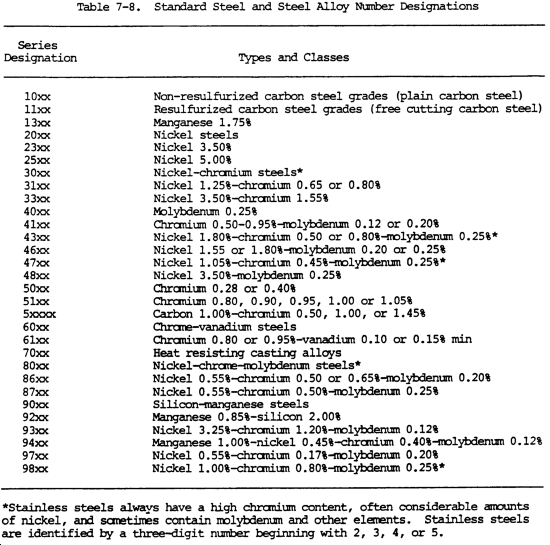
b. Two letters are often used as a prefix to the numerals. The letter C indicates basic open hearth carbon steels, and E indicates electric furnace carbon and alloy steels. The letter H is sometimes used as a suffix to denote steels manufactured to meet hardenability limits.
c. The first two digits indicate the major alloying metals in a steel, such as manganese, nickel-chromium, and chrome-molybdenum.
d. The last digits indicate the approximate middle of the carbon content range in percent. For example, 0.21 indicates a range of 0.18 to 0.23 percent carbon. In a few cases, the system deviates from this rule, and some carbon ranges relate to the ranges of manganese, sulfur, phosphorous, chromium, and other elements.
e. The system designates the major elements of a steel and the approximate carbon range of the steel. It also indicates the manufacturing process used to produce the steel. The complete designation system is shown in table 7-9.
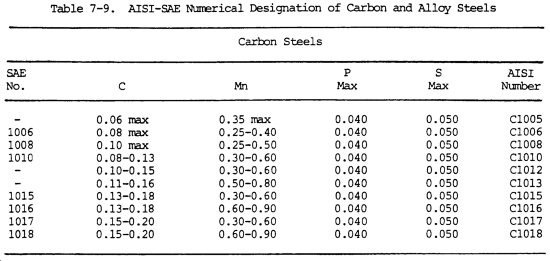
f. The number 2340 by this system indicates a nickel steel with approximately 3 percent nickel and 0.40 percent carbon. The number 4340 indicates a nickel-chrome-molybdenum metal with 0.40 percent carbon.
S. A. E. Steel Specifications
The following numerical system for identifying carbon and alloy steels of various specifications has been adopted by the Society of Automotive Engineers.
COMPARISION
A.I.S.I.--S.A.E. Steel Specifications
The ever-growing variety of chemical compositions and quality requirements of steel specifications have resulted in several thousand different combinations of chemical elements being specified to meet individual demands of purchasers of steel products.
The S.A.E. developed a system of nomenclature for identification of various chemical compositions which symbolize certain standards as to machining, heat treating, and carburizing performance. The American Iron and Steel Institute has now gone further in this regard with a new standardization setup with similar nomenclature, but with restricted carbon ranges and combinations of other elements which have been accepted as standard by all manufacturers of bar steel in the steel industry. The Society of Automotive Engineers have, as a result, revised most of their specifications to coincide with those set up by the American Iron and Steel Institute.
PREFIX LETTERS
No prefix for basin open-hearth alloy steel.
(B) Indicates acid Bessemer carbon steel.
(C) Indicates basic open-hearth carbon steel
(E) Indicates electric furnace steel.
NUMBER DESIGNATIONS
(10XX series) Basic open-hearth and acid Bessemer carbon steel grades, non-sulfurized and non-phosphorized.
(11XX series) Basic open-hearth and acid Bessemer carbon steel grades, sulfurized but not phosphorized.
(1300 series) Manganese 1.60 to 1.90%
(23XX series) Nickel 3.50%
(25XX series) Nickel 5.0%
(31XX series) Nickel 1.25%-chromium 0.60%
(33XX series) Nickel 3.50%-chromium 1.60%
(40XX series) Molybdenum
(41XX series) Chromium molybdenum
(43XX series) Nickel-chromium-molybdenum
(46XX series) Nickel 1.65%-molybdenum 0.25%
(48XX series) Nickel 3.25%-molybdenum 0.25%
(51XX series) Chromium
(52XX series) Chromium and high carbon
(61XX series) Chromium vanadium
(86XX series) Chrome nickel molybdenum
(87XX series) Chrome nickel molybdenum
(92XX series) Silicon 2.0%-chromium
(93XX series) Nickel 3.0%-chromium-molybdenum
(94XX series) Nickel-chromium-molybdenum
(97XX series) Nickel-chromium-molybdenum
(98XX series) Nickel-chromium-molybdenum
7-6. STANDARD DESIGNATION SYSTEM FOR ALUMINUM AND ALUMINUM ALLOYS
a. Currently, there is no standard designation system for aluminum castings. Wrought aluminum and aluminum alloys have a standard four-digit numbering system.
b. The first digit represents the major alloying element.
c. The second digit identifies alloy modifications (a zero means the original alloy).
d. The last two digits seine only to identify different aluminum alloys which are in common commercial use, except in the 1XXX class. In the 1XXX class, the last two digits indicate the aluminum content above 99 percent, in hundredths of one percent.
e. In number 1017, the 1 indicates a minimum aluminum composition of 99 percent; the 0 indicates it is the original composition; and the 17 indicates the hundredths of one percent of aluminum above the 99 percent minimum composition. In this example, the aluminum content is 99.17 percent.
f. In number 3217, the 3 indicates a manganese aluminum alloy; the 2 indicates the second modification of this particular alloy; and the 17 indicates a commonly used commercial alloy.
g. The various classes of aluminum and aluminum alloys are identified by numbers as shown in table 7-10.

7-7. STANDARD DESIGNATION SYSTEM FOR MAGNESIUM AND MAGNESIUM ALLOYS
a. Wrought magnesium and magnesium alloys are identified by a combination of letters and numbers. The letters identify which alloying elements were used in the magnesium alloy (table 7-11). Numbers, which may follow the letters, designate the percentage of the elements in the magnesium alloy. There may be an additional letter following the percentage designators which indicates the alloy modifications. For example, the letter A means 1; B means 2; and C means 3.
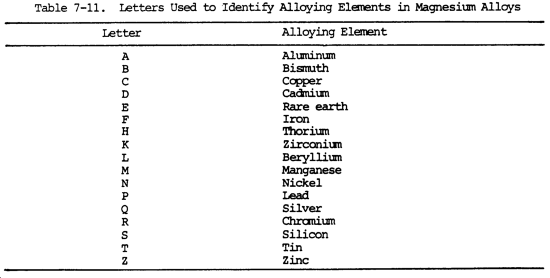
b. In the identification number AZ93C, the A indicates aluminum; the Z indicates zinc; the 9 indicates there is 9 percent aluminum in the alloy; the 3 indicates there is 3 percent zinc in the alloy; and the C indicates the third modification to the alloy. The first digit, 9 in this example, always indicates the percentage of the first letter, A in this example. The second digit gives the percentage of the second letter (table 7-12).
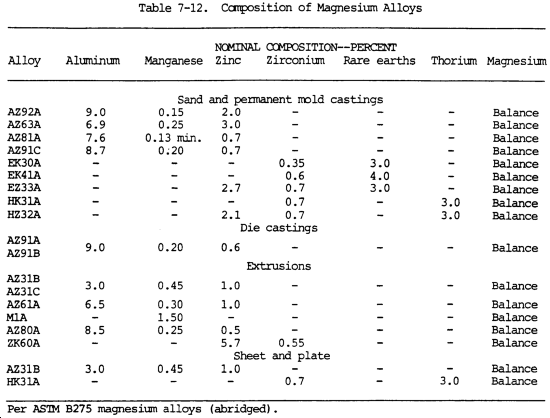
c. Temper designations may be added to the basic magnesium designation, the two being separated by a dash. The temper designations are the same as those used for aluminum.
7-8. STANDARD DESIGNATION SYSTEM FOR COPPER AND COPPER ALLOYS
a. There are over 300 different wrought copper and copper alloys commercially available. The Copper Development Association, Inc., has established an alloy designation system that is widely accepted in North America. It is not a specification system but rather a method of identifying and grouping different coppers and copper alloys. This system has been updated so that it now fits the unified numbering system (UNS). It provides one unified numbering ring system which includes all of the commercially available metals and alloys. The UNS designation consists of the prefix letter C followed by a space, three digits, another space, and, finally, two zeros.
b. The information shown by table 7-13 is a grouping of these copper alloys by common names which normally include the constituent alloys. Welding information for those alloy groupings is provided. There may be those alloys within a grouping that may have a composition sufficiently different to create welding problems. These are the exception, however, and the data presented will provide starting point guidelines. There are two categories, wrought materials and cast materials. The welding information is the same whether the material is cast or rolled.
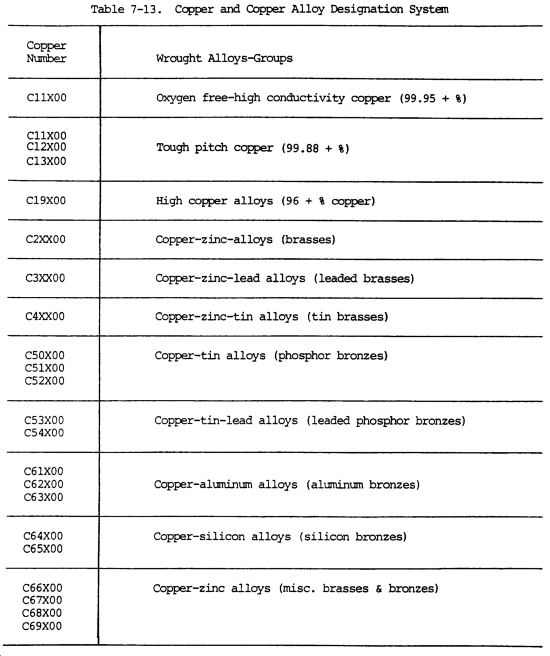
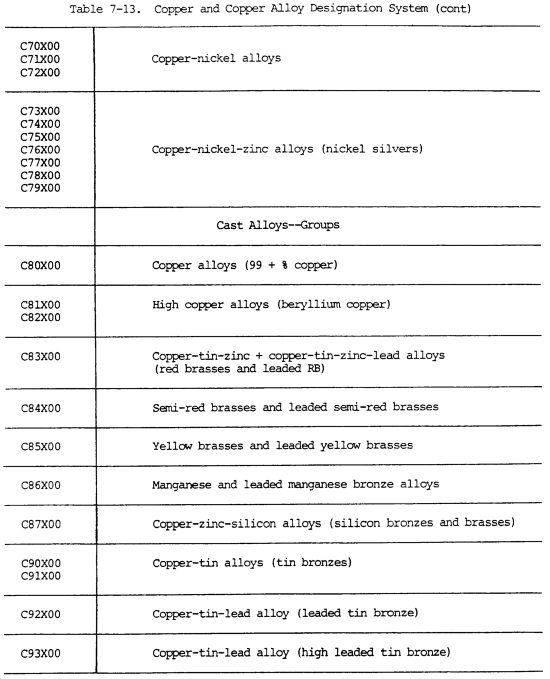
7-9. STANDARD DESIGNATION SYSTEM FOR TITANIUM
There is no recognized standard designation system for titanium and titanium alloys. However, these compositions are generally designated by using the chemical symbol for titanium, Ti, followed by the percentage number(s) and the chemical symbols(s) of the alloying element(s). For example, Ti-5 A1-2.5 Sn would indicate that 5 percent aluminum and 2-1/2 percent tin alloying elements are present in the titanium metal.
Authorization Letter |


